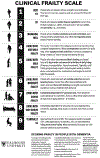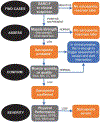Review of Blood Pressure Control in Vulnerable Older Adults: The Role of Frailty and Sarcopenia
- PMID: 40697250
- PMCID: PMC12282481
- DOI: 10.3390/jvd4020018
Review of Blood Pressure Control in Vulnerable Older Adults: The Role of Frailty and Sarcopenia
Abstract
The aging of the global population over recent decades has resulted in an increased prevalence of hypertension in older adults. Hypertension develops with increasing age primarily due to a disastrous feedback loop of increased arterial stiffness and maladaptive hemodynamics; this is compounded by age-related changes in physiology. The risk of adverse hypertension-related outcomes concurrently increases with age, and optimal blood pressure (BP) control in older adults thus becomes increasingly important each year. The results of several randomized clinical trials (RCTs) evaluating antihypertension strategies in older adults have concluded that the potential benefits of intensive BP management outweigh the risks of harm. However, the exclusion of frail, multimorbid, and institutionalized individuals limits the generalizability of such findings to the broader population of older patients with hypertension. Secondary analyses and external studies have continued to support intensive BP control strategies in older adults with frailty or sarcopenia. Therefore, based on available evidence, clinicians should continue practicing intensive BP control strategies in the older population, yet careful consideration of functional status, life expectancy, medication side effects, polypharmacy, and multimorbidity must take place to avoid unnecessary harm. Strategies must then be tailored to accommodate modifiers such as frailty and sarcopenia in older adults with hypertension. Knowledge gaps underscore the need for future studies evaluating BP management in older adults that incorporate greater proportions of multimorbid and institutionalized individuals with frailty, assess personalization of treatment, and identify subgroups in which optimal BP levels exist or the permissibility of higher BP levels is safer than BP reduction.
Keywords: frailty; hypertension management; older adults; sarcopenia.
Conflict of interest statement
Conflicts of Interest: The authors declare no conflicts of interest.
Figures



References
-
- Ageing and Health. Available online: https://www.who.int/news-room/fact-sheets/detail/ageing-and-health (accessed on 14 March 2025).
-
- Maddox KEJ; Elkind MS; Aparicio HJ; Commodore-Mensah Y; de Ferranti SD; Dowd WN; Hernandez AF; Khavjou O; Michos ED; Palaniappan L; et al. Forecasting the Burden of Cardiovascular Disease and Stroke in the United States Through 2050—Prevalence of Risk Factors and Disease: A Presidential Advisory From the American Heart Association. Circulation 2024, 150, e65–e88. 10.1161/cir.0000000000001256. - DOI - PubMed
-
- Martin SS; Aday AW; Allen NB; Almarzooq ZI; Anderson CA; Arora P; Avery CL; Baker-Smith CM; Bansal N; Beaton AZ; et al. 2025 Heart Disease and Stroke Statistics: A Report of US and Global Data From the American Heart Association. Circulation 2025, 151, e41–e660. 10.1161/cir.0000000000001303. - DOI - PMC - PubMed
Grants and funding
LinkOut - more resources
Full Text Sources
